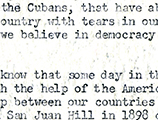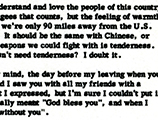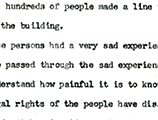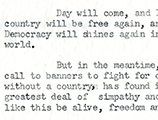The Cuban Experience in Florida: Revolution and Exodus
Lesson Plans
Letters to the Cuban Refugee Assistance Program
Lesson Plan for Grades 9-12

This lesson has been reviewed and approved by CPALMS.
Overview
The Cuban Refugee Assistance Program (CRA) was an unprecedented effort brought about by the mass exodus of Cubans from their homeland. The CRA provided health, employment and educational services to Cuban refugees upon their arrival in the United States. In this lesson, students will analyze letters written by refugees who worked for the Cuban Refugee Assistance Program.
Background Information
These letters, written by Cuban refugees to the staff of the Cuban Refugee Assistance Program (CRA), provide insight into the refugee experience in the United States. Since all of these individuals worked for the CRA, they also demonstrate how Cubans interacted with the CRA and the impact of the program on the Cuban community.
The CRA provided health, employment and educational services to Cuban refugees upon their arrival in the United States. The program, approved by President John F. Kennedy in 1961, was administered in Florida by the state's Department of Public Welfare until 1974. The CRA was an unprecedented effort brought about by the mass exodus of Cubans from their homeland following the Revolution of 1959. From the early 1960s to the mid-1990s, more than one million Cubans immigrated to the United States. The majority settled in South Florida.
At the national level, the CRA was an important component of U.S. foreign policy during the Cold War. The U.S. hoped that programs like the CRA would help improve the reputation of the American government around the world. The CRA also allowed the U.S. to oppose the government of Fidel Castro by strengthening the Cuban exile community.
At the local level, the CRA helped alleviate social and economic problems created by the influx of Cuban refugees into Miami and South Florida. If not for federal assistance under the CRA, Florida and especially Miami-Dade County could not have assumed the financial costs of the Cuban refugee crisis.
Objectives
Students will:
- Analyze primary source documents.
- Write about history using primary sources.
- Learn about the Cuban refugee experience.
- Understand 1960s Cuban immigration in the context of the Cold War, Florida history, and United States history.
Grades
9-12
Next Generation Sunshine State Standards
-
SS.912.A.6.15: Examine key events and peoples in Florida history as they relate to United States history.
Examples are Mosquito Fleet, “Double V Campaign,” construction of military bases and WWII training centers, 1959 Cuban coup and its impact on Florida, development of the space program and NASA.
Florida Standards
- LAFS.910.RH.1.2: Determine the central ideas or information of a primary or secondary source; provide an accurate summary of how key events or ideas develop over the course of the text.
- LAFS.1112.RH.1.2: Determine the central ideas or information of a primary or secondary source; provide an accurate summary that makes clear the relationships among the key details and ideas.
Materials Needed
- Document Analysis Worksheet from the National Archives and Records Administration
- Selected letters to the Cuban Refugee Assistance Program

Letter from Gustavo Alonso de la Torre, August 4, 1961
De la Torre found a teaching job in Pennsylvania.

Letter from Ana Anders, July 26, 1961
Anders worked as a medical social worker in Cuba before coming to the United States.

Letter from Manuel Minagorri, November 27, 1962
Minagorri explains the uncertainty Cuban refugees face upon arriving in the United States.

Letter from Joaquin Miranda, May 20, 1961
Miranda relates what it means to him to live in the United States.
Procedure
Part I: Introducing Content
These letters, written by Cuban refugees to the staff of the Cuban Refugee Assistance Program, provide insight into the refugee experience. The Cuban Refugee Assistance Program provided health, employment and educational services to Cuban refugees upon their arrival in the United States. Since all of these individuals worked for the CRA, they also demonstrate how Cubans interacted with the CRA and the impact of the program on the Cuban community.
Part II: Primary Source Analysis
- Have students read at least two personal accounts from the Cuban Refugee Letters. These letters provide insight into the experience of Cuban refugees, especially as they relate to the work of the Cuban Refugee Assistance Program.
- Ask students to begin to list the key ideas that emerge from the Cuban refugee letters, using the Document Analysis Worksheet.
Part III: Writing About the Refugee Experience
Have students write a brief journal entry on which aspect of the refugee experience is most interesting to them. Have students explain in their journal entries how the letters impact their understanding of the refugee experience.
Extension Activities
For teachers in South Florida or in areas with a large Cuban community, Cuban and Cuban-American students will certainly add to the class’ understanding of Cuba and Cuban immigration. Encourage these students to bring relatives into class and/or record stories from their family members.

 Listen: The Latin Program
Listen: The Latin Program
